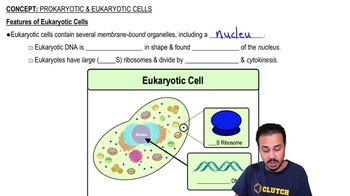Table of contents
- 1. Introduction to Biology2h 42m
- 2. Chemistry3h 40m
- 3. Water1h 26m
- 4. Biomolecules2h 23m
- 5. Cell Components2h 26m
- 6. The Membrane2h 31m
- 7. Energy and Metabolism2h 0m
- 8. Respiration2h 40m
- 9. Photosynthesis2h 49m
- 10. Cell Signaling59m
- 11. Cell Division2h 47m
- 12. Meiosis2h 0m
- 13. Mendelian Genetics4h 44m
- Introduction to Mendel's Experiments7m
- Genotype vs. Phenotype17m
- Punnett Squares13m
- Mendel's Experiments26m
- Mendel's Laws18m
- Monohybrid Crosses19m
- Test Crosses14m
- Dihybrid Crosses20m
- Punnett Square Probability26m
- Incomplete Dominance vs. Codominance20m
- Epistasis7m
- Non-Mendelian Genetics12m
- Pedigrees6m
- Autosomal Inheritance21m
- Sex-Linked Inheritance43m
- X-Inactivation9m
- 14. DNA Synthesis2h 27m
- 15. Gene Expression3h 20m
- 16. Regulation of Expression3h 31m
- Introduction to Regulation of Gene Expression13m
- Prokaryotic Gene Regulation via Operons27m
- The Lac Operon21m
- Glucose's Impact on Lac Operon25m
- The Trp Operon20m
- Review of the Lac Operon & Trp Operon11m
- Introduction to Eukaryotic Gene Regulation9m
- Eukaryotic Chromatin Modifications16m
- Eukaryotic Transcriptional Control22m
- Eukaryotic Post-Transcriptional Regulation28m
- Eukaryotic Post-Translational Regulation13m
- 17. Viruses37m
- 18. Biotechnology2h 58m
- 19. Genomics17m
- 20. Development1h 5m
- 21. Evolution3h 1m
- 22. Evolution of Populations3h 52m
- 23. Speciation1h 37m
- 24. History of Life on Earth2h 6m
- 25. Phylogeny2h 31m
- 26. Prokaryotes4h 59m
- 27. Protists1h 12m
- 28. Plants1h 22m
- 29. Fungi36m
- 30. Overview of Animals34m
- 31. Invertebrates1h 2m
- 32. Vertebrates50m
- 33. Plant Anatomy1h 3m
- 34. Vascular Plant Transport1h 2m
- 35. Soil37m
- 36. Plant Reproduction47m
- 37. Plant Sensation and Response1h 9m
- 38. Animal Form and Function1h 19m
- 39. Digestive System1h 10m
- 40. Circulatory System1h 57m
- 41. Immune System1h 12m
- 42. Osmoregulation and Excretion50m
- 43. Endocrine System1h 4m
- 44. Animal Reproduction1h 2m
- 45. Nervous System1h 55m
- 46. Sensory Systems46m
- 47. Muscle Systems23m
- 48. Ecology3h 11m
- Introduction to Ecology20m
- Biogeography14m
- Earth's Climate Patterns50m
- Introduction to Terrestrial Biomes10m
- Terrestrial Biomes: Near Equator13m
- Terrestrial Biomes: Temperate Regions10m
- Terrestrial Biomes: Northern Regions15m
- Introduction to Aquatic Biomes27m
- Freshwater Aquatic Biomes14m
- Marine Aquatic Biomes13m
- 49. Animal Behavior28m
- 50. Population Ecology3h 41m
- Introduction to Population Ecology28m
- Population Sampling Methods23m
- Life History12m
- Population Demography17m
- Factors Limiting Population Growth14m
- Introduction to Population Growth Models22m
- Linear Population Growth6m
- Exponential Population Growth29m
- Logistic Population Growth32m
- r/K Selection10m
- The Human Population22m
- 51. Community Ecology2h 46m
- Introduction to Community Ecology2m
- Introduction to Community Interactions9m
- Community Interactions: Competition (-/-)38m
- Community Interactions: Exploitation (+/-)23m
- Community Interactions: Mutualism (+/+) & Commensalism (+/0)9m
- Community Structure35m
- Community Dynamics26m
- Geographic Impact on Communities21m
- 52. Ecosystems2h 36m
- 53. Conservation Biology24m
15. Gene Expression
Eukaryotic RNA Processing and Splicing
Problem 8`
Textbook Question
Would the coupling of the processes shown in Figure 17.24 be found in a eukaryotic cell? Explain why or why not.
<IMAGE>
 Verified step by step guidance
Verified step by step guidance1
Begin by identifying the processes shown in Figure 17.24. Typically, this figure might depict processes such as transcription and translation, which are key steps in gene expression.
Understand the location of these processes in eukaryotic cells. Transcription occurs in the nucleus, where DNA is transcribed into mRNA. Translation occurs in the cytoplasm, where ribosomes synthesize proteins from mRNA.
Consider the concept of coupling in cellular processes. In prokaryotic cells, transcription and translation can be coupled, meaning they occur simultaneously in the cytoplasm. However, in eukaryotic cells, these processes are separated by the nuclear membrane.
Evaluate the implications of this separation. The nuclear membrane in eukaryotic cells prevents the direct coupling of transcription and translation, as mRNA must be processed and transported out of the nucleus before translation can occur.
Conclude by explaining why coupling of these processes, as shown in the figure, would not be found in eukaryotic cells due to the spatial and temporal separation imposed by the nuclear membrane.
 Verified video answer for a similar problem:
Verified video answer for a similar problem:This video solution was recommended by our tutors as helpful for the problem above
Video duration:
41sPlay a video:
Was this helpful?
Key Concepts
Here are the essential concepts you must grasp in order to answer the question correctly.
Coupling of Transcription and Translation
In prokaryotic cells, transcription and translation are coupled, meaning they occur simultaneously in the cytoplasm. This is possible because prokaryotes lack a nucleus, allowing ribosomes to begin translating mRNA as it is being transcribed. In eukaryotic cells, transcription occurs in the nucleus, and translation occurs in the cytoplasm, preventing direct coupling.
Recommended video:
Guided course

Review of Transcription vs. Translation
Eukaryotic Cell Compartmentalization
Eukaryotic cells are characterized by compartmentalization, with distinct organelles such as the nucleus and cytoplasm. This separation means that transcription occurs in the nucleus, where DNA is housed, and mRNA must be processed and transported to the cytoplasm for translation, preventing simultaneous transcription and translation.
Recommended video:
Guided course

Features of Eukaryotic Cells
mRNA Processing in Eukaryotes
In eukaryotic cells, mRNA undergoes several processing steps before translation, including capping, polyadenylation, and splicing. These modifications are necessary for mRNA stability and export from the nucleus to the cytoplasm. This processing further separates transcription and translation temporally and spatially, unlike in prokaryotes.
Recommended video:
Guided course

Eukaryotic RNA Processing and Splicing

 2:32m
2:32mWatch next
Master Eukaryotic RNA Processing and Splicing with a bite sized video explanation from Jason
Start learningRelated Videos
Related Practice





















